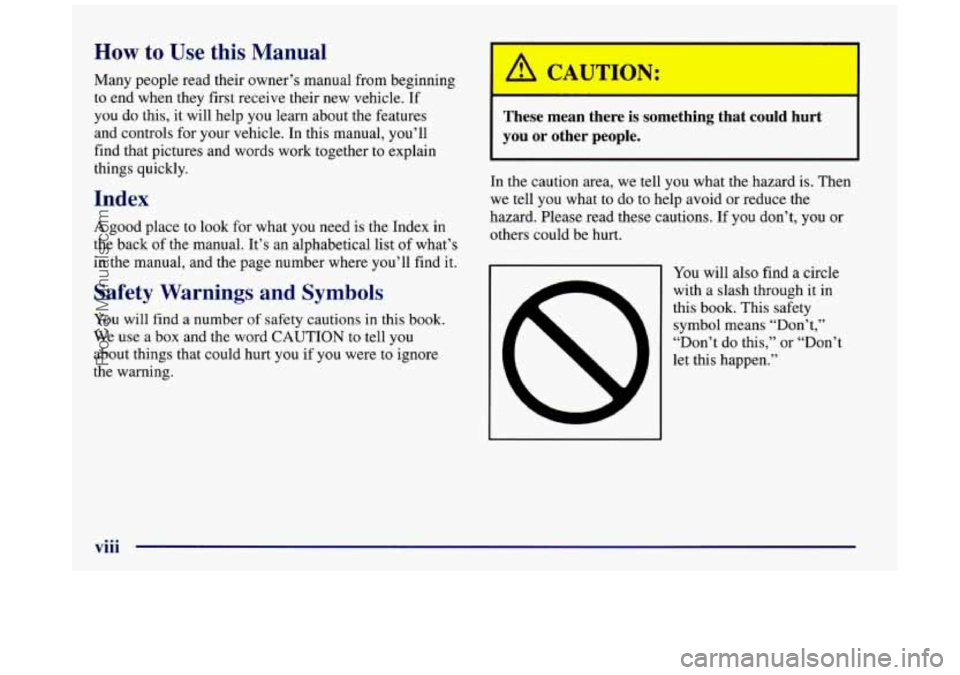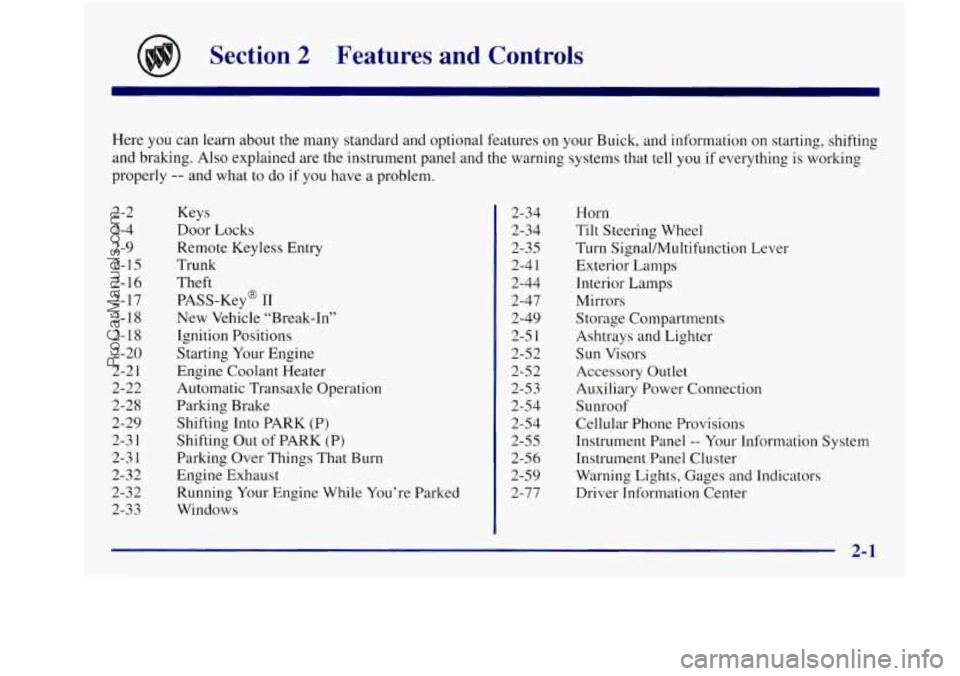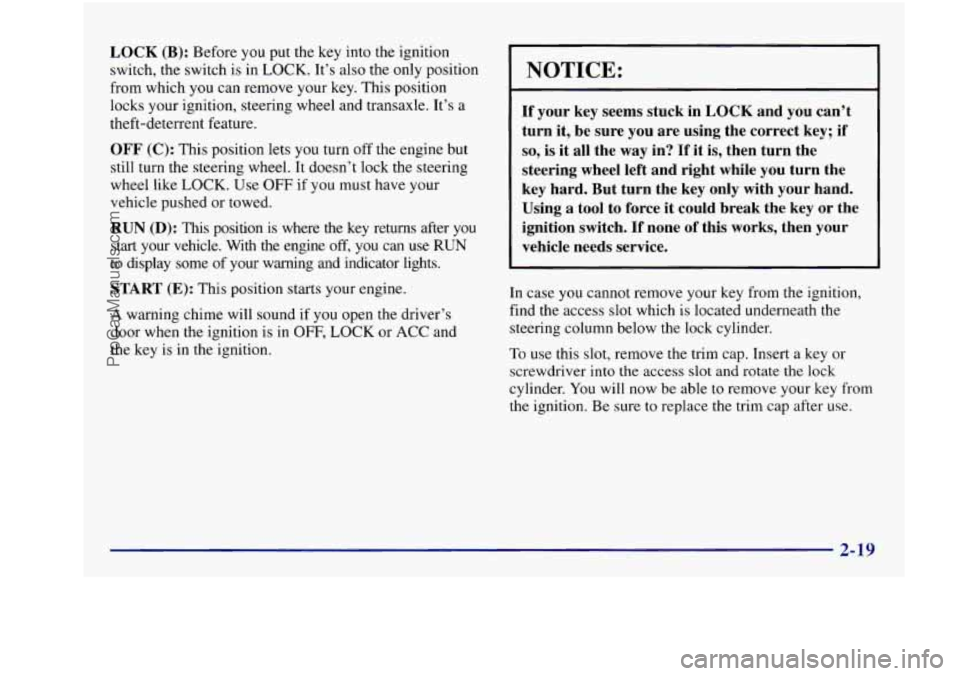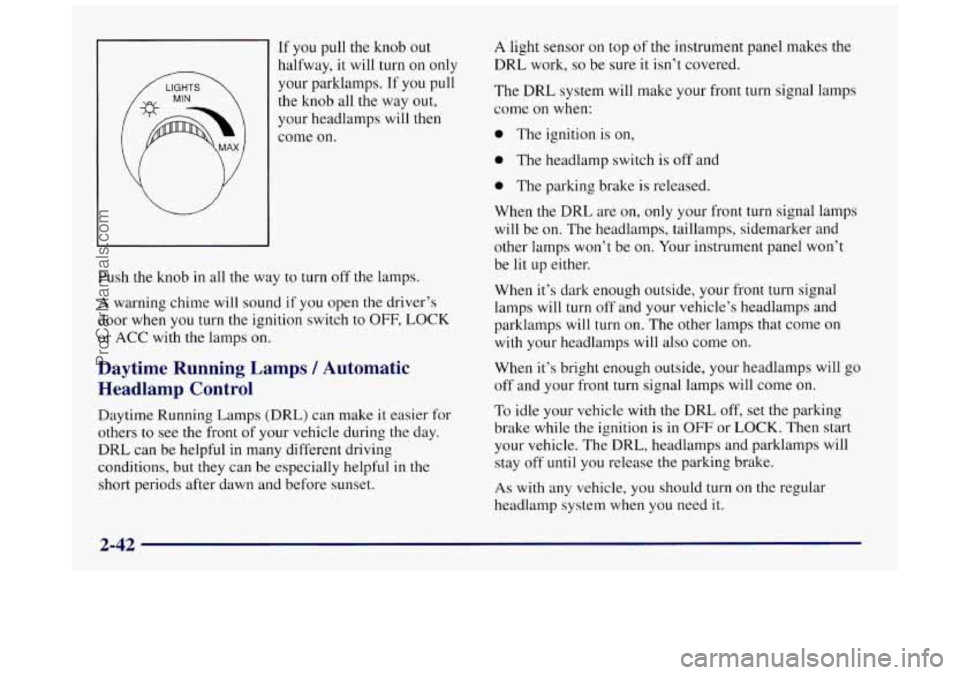Page 12 of 422

How to Use this Manual
Many people read their owner’s manual from beginning
to end when they first receive their new vehicle. If
you do this,
it will help you learn about the features
and controls for your vehicle. In this manual, you’ll
find that pictures and words work together to explain
things quickly.
Index
A good place to look for what you need is the Index in
the back
of the manual. It’s an alphabetical list of what’s
in the manual, and the page number where you’ll find it.
Safety Warnings and Symbols
You will find a number of safety cautions in this book.
We use a box and the word CAUTION to tell
you
about things that could hurt you if you were to ignore
the warning.
These mean there is something that could hurt
you or other people.
In the caution area, we tell you what the hazard is. Then
we tell you what to do to help avoid or reduce the
hazard. Please read these cautions. If you don’t, you or
others could be hurt.
You will also find a circle
with a slash through it in
this book. This safety
symbol means “Don’t,”
“Don’t do this,’’ or “Don’t
let this happen.”
viii
ProCarManuals.com
Page 13 of 422
Vehicle Damage Warnings
Also, in this book you will find these notices:
NOTICE:
I
These mean there is something that could
damage your vehicle.
In the notice area, we tell you about something that can
damage your vehicle. Many times, this damage would
not be covered by your warranty, and it could be
costly. But the notice will tell
you what to do to help
avoid the damage.
When you read other manuals, you might see
CAUTION and NOTICE warnings in different
colors or in different words.
You’ll also see warning labels on your vehicle. They use
the same words,
CAUTION or NOTICE.
ix
ProCarManuals.com
Page 14 of 422
Vehicle Symbols
These are some of the symbols you may find on your vehicle.
For example,
these symbols
are used on an
original battery:
POSSIBLE A
CAUTION
INJURY
PROTECT EYES BY
SHIELDING
CAUSTIC
ACID COULD BAllERY
CAUSE
BURNS
SPARK
OR ,111,
COULD FLAME
EXPLODE BAllERY
These symbols are important
for you and
your passengers
whenever your
vehicle is
driven:
DOOR LOCK
UNLOCK
FASTEN SEAT
BELTS
These symbols
have to do with
your lamps:
SIGNALS @ e
TURN
These symbols
are
on some of
your controls:
WINDSHIELD
WIPER
WINDSHIELD DEFROSTER
WINDOW
DEFOGGER
These symbols
are used on
warning and
indicator lights:
COOLANT -
TEMP -
CHARGING I-1
BAllERY
SYSTEM
BRAKE
(0)
COOLANT a
ENGINE OIL w,
PRESSURE
ANTI-LOCK
(@)
BRAKES
Here are some
other symbols
you may see:
FUSE
I
LIGHTER n
HORN )tr
SPEAKER
b
FUEL p3
ProCarManuals.com
Page 55 of 422
Securing a Child in the Built-in
Child Restraint
Now that the harness is adjusted to the correct height for
your child, you’re ready to use the child restraint’s
harness (E) to secure your child.
Don’t use the vehicle’s safety belts.
Using the vehicle’s regular safety belts on a child
seated on the child restraint cushion can cause
serious injury to the child in a sudden stop or
crash.
If a child is the proper size for the built-in
child restraint, secure the child using the child
restraint’s harness. But children who are too
large for the built-in child restraint should sit on
the vehicle’s regular seat and use the regular
safety belts.
WARNING! FAILURE TO FOLLOW THE
MANUFACTURER’S INSTRUCTIONS
ON THE
USE OF THIS CHILD RESTRAINT SYSTEM
CAN RESULT IN
YOUR CHILD STRIKING THE
VEHICLE’S INTERIOR DURING A SUDDEN
STOP
OR CRASH.
SNUGLY ADJUST THE BELTS PROVIDED WITH
THIS CHILD RESTRAINT AROUND YOUR CHILD.
ProCarManuals.com
Page 77 of 422

Section 2 Features and Controls
Here you can learn about the many standard and optional features on your Buick, and information on starting, shifting
and braking. Also explained are the instrument panel and the warning systems that tell you
if everything is working
properly
-- and what to do if you have a problem.
2-2
2-4
2-9
2-15
2-16
2- 17
2-18
2-18
2-20
2-2 1
2-22
2-28
2-29
2-3
1
2-3 1
2-32
2-3 2
2-33 Keys
Door
Locks
Remote Keyless
Entry
Trunk
Theft
PASS-Key@
I1
New Vehicle “Break-In”
Ignition Positions
Starting Your Engine
Engine Coolant Heater Automatic Transaxle Operation
Parking Brake Shifting Into PARK
(P)
Shifting Out of PARK (P)
Parking Over Things That Burn
Engine Exhaust
Running Your Engine While You’re Parked
Windows 2-34
2-34
2-35
2-4
1
2-44
2-47
2-49
2-5 1
2-52
2-52 2-5 3
2-54
2-54
2-55
2-56 2-59
2-77 Horn
Tilt Steering Wheel
Turn Signal/Multifunction Lever
Exterior Lamps
Interior Lamps
Mirrors
Storage Compartments
Ashtrays and Lighter
Sun Visors
Accessory Outlet
Auxiliary Power Connection
Sunroof
Cellular Phone Provisions
Instrument Panel
-- Your Information System
lnstrument Panel Cluster
Warning Lights, Gages and Indicators
Driver Information Center
ProCarManuals.com
Page 95 of 422

LOCK (B): Before you put the key into the ignition
switch, the switch is in LOCK. It’s also the only position
from which you can remove your key. This position
locks your ignition, steering wheel and transaxle. It’s a
theft-deterrent feature.
OFF (C): This position lets you turn off the engine but
still turn the steering wheel. It doesn’t lock the steering
wheel like LOCK. Use
OFF if you must have your
vehicle pushed or towed.
RUN (D): This position is where the key returns after you
start your vehicle. With the engine off, you can use RUN
to display some of your warning and indicator lights.
START (E): This position starts your engine.
A warning chime will sound if
you open the driver’s
door when the ignition is in
OFF, LOCK or ACC and
the key is in the ignition.
NOTICE:
If your key seems stuck in LOCK and you can’t
turn it, be sure
you are using the correct key; if
so, is it all the way in? If it is, then turn the
steering wheel left and right while you turn the
key hard. But turn the key only with your hand.
Using a tool to force it could break the key or the
ignition switch.
If none of this works, then your
vehicle needs service.
In case you cannot remove your key from the ignition,
find the access
slot which is located underneath the
steering column below the lock cylinder.
To use this slot, remove the trim cap. Insert a key or
screwdriver
into the access slot and rotate the lock
cylinder. You will now be able to remove your key
from
the ignition. Be sure to replace the trim cap after use.
ProCarManuals.com
Page 104 of 422
Parking Brake
To set the parking brake,
hold the regular brake
pedal down with your
right foot. Push down
the
parking brake pedal with
your
left foot,
To release the parking brake, hold the regular brake
pedal down with your right foot and push the parking
brake pedal with your left foot. When
you lift your left
foot, the parking brake pedal will follow it
to the
released position.
A warning chime will sound if the parking brake is set,
the ignition
is on and the shift lever is not in PARK (P)
or NEUTRAL (N).
I NOTICE:
Driving with the parking brake on can cause
your rear brakes to overheat. You may have to
replace them, and
you could also damage other
parts
of your vehicle.
If you are towing a trailer and are parking on any hill,
see “Towing
a Trailer” in the Index. That section shows
what
to do first to keep the trailer from moving.
2-28
ProCarManuals.com
Page 118 of 422

If you pull the knob out
halfway,
it will turn on only
your parklamps. If you pull
the knob all the way out,
your headlamps
will then
come on.
Push the knob
in all the way to turn off the lamps.
A warning chime will sound if you open the driver’s
door when you turn the ignition switch to
OFF, LOCK
or
ACC with the lamps on.
Daytime Running Lamps / Automatic
Headlamp Control
Daytime Running Lamps (DRL) can make it easier for
others to see the front
of your vehicle during the day.
DRL can be helpful in many different driving
conditions, but they can be especially helpful
in the
short periods after dawn and before sunset.
A light sensor on top of the instrument panel makes the
DRL work,
so be sure it isn’t covered.
The DRL system will make your front turn signal lamps
come on when:
0 The ignition is on,
0 The headlamp switch is off and
0 The parking brake is released.
When the DRL are on, only your front turn signal lamps
will be on. The headlamps, taillamps, sidemarker and
other lamps won’t be on. Your instrument panel won’t
be lit up either.
When it’s dark enough outside, your front turn signal
lamps will turn off and your vehicle’s headlamps and
parklamps will turn
on. The other lamps that come on
with your headlamps will also come on.
When it’s bright enough outside, your headlamps will
go
off and your front turn signal lamps will come on.
To idle your vehicle with the DRL off, set the parking
brake while
the ignition is in OFF or LOCK. Then start
your vehicle. The DRL, headlamps and parklamps will
stay off until you release the parking brake.
As with any vehicle, you should turn on the regular
headlamp system when you need
it.
2-42
ProCarManuals.com